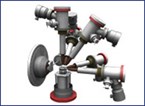First Test Of New X-Ray Laser Strips Neon Bare

It takes a lot of energy to strip all ten electrons from an atom of neon. Doing it from the inside out, knocking away the most-closely-held, innermost electrons first, is an even rarer feat. But the brilliant X-ray pulses of the Linac Coherent Light Source have done just that, in the successful first test of the unprecedented X-ray laser with its first scientific instrument. The result demonstrates the machine's unique capabilities—with the world's brightest and shortest X-ray laser pulses—and marks the first of two milestones in readiness for the launch of LCLS scientific user experiments this October.
Early on September 12, scientists at the Department of Energy's SLAC National Accelerator Laboratory introduced puffs of neon gas into the sample chamber of the LCLS Atomic, Molecular and Optical science instrument. The AMO instrument's ion detector picked up showers of positively-charged neon nuclei—where the charge indicates the number of missing electrons—ranging from partially to fully ionized. The scientists were able to adjust the proportion of different neon species, from non-ionized Ne (no missing electrons) to Ne10+, lacking all 10 electrons, by fine-tuning the powerful LCLS X-ray beam.
"This truly shows we're reaching a new regime with the LCLS, to access physics that's never been available before," said instrument scientist John Bozek, who has spent the past 3.5 years planning and developing the AMO instrument.
"We're making Ne10+ in a new way, removing electrons from the inside-out," Bozek said. He noted that fully-ionized neon has been achieved before, using optical-wavelength lasers and starting with the outer-most electrons, which are less affected by the atomic nucleus's strong pull. Last weekend's result at SLAC marks the first time it's been done using the high-energies of X-rays, and from the inside moving outward.
The LCLS and AMO teams, including Bozek and co-AMO instrument scientist Christoph Bostedt, are using the neon gas experiment as a tool for instrument commissioning—tuning and calibrating both the LCLS X-ray beam and the AMO instrument controls and optics. Several future AMO scientific users, who submitted successful proposals to perform experiments later this year, are at SLAC now, learning to use the machine and providing valuable guidance. Their input will help the SLAC AMO team tune the instrument to best meet users' experimental needs.
The AMO instrument was designed to explore the interaction of the LCLS's intense X-ray pulses with atoms and molecules, to gain an understanding of how their electronic structure responds. Ultrashort X-ray pulses from the LCLS also offer the opportunity to follow the evolution of chemical reactions on their natural time scales.
"The AMO instrument was built to do two things: explore high-intensity physics, and to examine time-resolved physics of atoms, molecules and clusters of molecules," Bozek said. "We've demonstrated that the first is accessible. Hopefully within a week or two, we'll demonstrate the other as well."
Bozek and his colleagues will test the instrument's ability to resolve extremely fast molecular events later this month. The researchers will use an infrared laser to stimulate a sample material, creating molecular change or motion to be captured using the LCLS's X-ray laser pulses and the AMO instrument. Due to the extremely brief duration of each LCLS pulse, these "pump-probe" tests could resolve molecular motions over periods as short as 100 femtoseconds, Bozek said. Those tests will complete commissioning of the AMO instrument for the launch of LCLS scientific work October 1.
"The LCLS beam and AMO instrument have performed exactly as designed," said LCLS Director Joachim Stöhr. "It's a testament to the whole LCLS team that they produced these beautiful results on the first go, with first X-ray lasing last spring and now AMO operations. We look forward to seeing the fully-commissioned AMO instrument at work in the first LCLS scientific user experiments next month."
SOURCE: SLAC National Accelerator Laboratory
